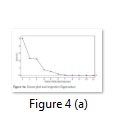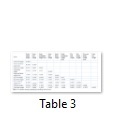![]()
Screening for drought tolerance: comparison of maize hybrids under water deficit condition
Qurban Ali1*, Muhammad Ahsan1, Saif-ul-Malook1,4, Naila Kanwal1, Fawad Ali1, Arfan Ali3, Wazir Ahmed2, Muhammad Ishfaq5, Muhammad Saleem5
Adv. life sci., vol. 3, no. 2, pp. 51-58, February 2016
*- Corresponding Author: Qurban Ali (Email: saim1692@gmail.com)
Authors' Affiliation
2. Department of Soil & Environmental Sciences, MNS University of Agriculture Multan, Pakistan
3. IMBB, The University of Lahore, Lahore, Pakistan
4. Kunming Institute of Botany, University of Chinese Academy of Sciences, China
5. Molecular Genetics Research Laboratory, University of the Punjab Lahore, Pakistan
Abstract![]()
Introduction
Methods
Results
Discussion
Supplementary Data
References
Abstract
Background: Maize is an important cereal crop, grown throughout the globe for human food and livestock feed, but biotic and abiotic factors had shown adverse effects on biomass and grain yield. Changing climatic conditions have imposed drought (water scarcity) as a major problem to combat with yield losses and biomass in maize and other cereals.
Methods: The prescribed study was conducted to evaluate F1 hybrids at seedling subject to 45% moisture level. The data was recorded and subjected to multivariate analysis to find the significant variation attributed by various traits under stress conditions for efficient root/shoot development.
Results: Significant differences were found in F1 hybrids for all studied traits. Higher heritability was found for root length, shoot length and fresh shoot weight, while fresh shoot weight, dry shoot weight and dry root weight showed higher genetic advance. Significant correlation was found for dry root weight to fresh shoot length and fresh root length, fresh root weight to fresh root/shoot weight ratio and fresh shoot weight. The hybrids Sh-139×B-316, Raka-poshi×B-316, B-327×B-316, Sh-139×EV-340, EV-1097Q×EV-347, EV-1097Q×EV-340, EV-1097Q×Pop/209 and B-327×EV-340 showed higher and positive heterosis and heterobeltiosis for most of the studied traits. To assess the overall variation on dependent structure, we used multivariate analysis, an important tool in breeding program, for efficient selection.
Conclusions: EV-1097Q×Pop/209 and Sh-139×EV-340 showed significant results for root and shoot development under various water stress regimes at seedling stage, thus further studies should be carried out to find out the known and un-known loci regarding root and shoot development traits in high yielding maize cultivars under arid/semi-arid regions.
Keywords: Zea mays, drought stress, genetic components, multivariate analysis
Introduction
Maize (Zea mays L.) is the most extensively grown cereal throughout the globe, in terms of productivity; it is also a leading cereal of the world. Maize is a short duration, tropical crop but it is being successfully grown in temperate, tropical and sub-tropical regions of the world. A plant may experience biotic and abiotic stresses in the field like diseases attack, water scarcity, water logging, salinity, high and low temperature extremes and heavy metal toxicity, etc. either continuously or with some breaks at different times during the growing season. Abiotic stresses limit crop productivity [1]. Among various abiotic stresses drought stress or water deficit is an inevitable and recurring feature of world agriculture. It has been estimated that about one third of the world’s potentially arable land suffers from water shortage, and most of the remainder crop yields are often reduced by drought [2]. Maize is highly sensitive to drought stress, grain yield reduced due to sever water deficit conditions [3, 4]. Plant breeders use various statistical tools and methods to improve crop plant yield and production under varying environmental conditions [5-8]. To enhance drought tolerance to increase and water use efficiency, different strategies such as change of crops capable of producing acceptable yields under drought stress or rained conditions have to be achieved [9] or by genetics improvement through the successful breeding methods.
The only option is to increase the maize productivity per unit area of land and time, which can be achieved through selection of best genotype improved in breeding program and application of proper production management techniques.
The prescribed study was conducted on F1 hybrids for root and shoot development traits at seedling stage to evaluate drought tolerance, hierarchial clustering for efficient grouping of sensitive and tolerant maize hybrids.
Methods
The present study was carried out in the glasshouse of the Department of Plant Breeding and Genetics, University of Agriculture, Faisalabad (Pakistan) to evaluate the maize F1 hybrids for seedling traits during crop growing season 2012-13. The germplasm was consisted of 36 direct crosses developed through crossing of 6 males and 6 females following North Carolina matting scheme. The male parents were B-316, EV-340, POP/209, F-96, EV-347 and B-322, and females Raka-poshi, B-327, Sh-139, B-336, B-11 and EV-1097. Their F1 direct crosses (6×6) were as:
|
Codes |
F1 hybrids |
Codes |
F1 hybrids |
|
1 |
B-11×Pop/209 |
19 |
B-327×Pop/209 |
|
2 |
B-11×B-316 |
20 |
B-327×B-316 |
|
3 |
B-11×EV-340 |
21 |
B-327×EV-340 |
|
4 |
B-11×E-322 |
22 |
B-327×E-322 |
|
5 |
B-11×F-96 |
23 |
B-327×F-96 |
|
6 |
B-11×EV-347 |
24 |
B-327×EV-347 |
|
7 |
B-336×Pop/209 |
25 |
Raka-poshi×Pop/209 |
|
8 |
B-336×B-316 |
26 |
Raka-poshi×B-316 |
|
9 |
B-336×EV-340 |
27 |
Raka-poshi×EV-340 |
|
10 |
B-336×E-322 |
28 |
Raka-poshi×E-322 |
|
11 |
B-336×F-96 |
29 |
Raka-poshi×F-96 |
|
12 |
B-336×EV-347 |
30 |
Raka-poshi×EV-347 |
|
13 |
EV-1097Q×Pop/209 |
31 |
Sh-139×Pop/209 |
|
14 |
EV-1097Q×B-316 |
32 |
Sh-139×B-316 |
|
15 |
EV-1097Q×EV-340 |
33 |
Sh-139×EV-340 |
|
16 |
EV-1097Q×E-322 |
34 |
Sh-139×E-322 |
|
17 |
EV-1097Q×F-96 |
35 |
Sh-139×F-96 |
|
18 |
EV-1097Q×EV-347 |
36 |
Sh-139×EV-347 |
The F1 hybrids and their parents were grown in iron trays filled with sandy loam soil having pH 7.8 and EC 1.7 dS/m, following triplicate complete randomized design. Field capacity of the soil was determined before sowing. After 30 days of sowing, 45 percent of field capacity was maintained by volume on alternate days using a moisture meter (ΔT-NH2, Cambridge, England).
The data was recorded for various morphological traits including fresh root length (A) (cm), fresh shoot length (B) (cm), fresh root/shoot length ratio (C), fresh root weight (D) (g), fresh shoot weight (E) (g), fresh root/shoot weight ratio (F), dry root weight (G) (g), dry shoot weight (H) (g), dry root/shoot weight ratio (I), total dry weight (J) (g) and total fresh weight (K) (g). Analysis of variance was done to evaluate the significance of the results. Heritability, genetic advance, heterosis, heterobeltiosis, trend line for variation check, correlation, stepwise linear regression, principal component analysis, factor analysis and control charts were performed to evaluate overall results from the experiment [10].
Results
The results form table 1, indicated that there was a significant (at <0.05% probability level) difference among F1 hybrids for all morphological traits studied at seedling stage. The trend line for the mean performance of parents and F1 hybrids also heterosis and heterobeltiosis of F1 hybrids clearly indicated the presence of higher variation for all studied traits (Figures S1a-S11a: Supplementary Material Figures). The control chart (generalized variance, Figure 1 and EWMA, Figure 2) was performed to check out the control of the traits, factors and F1 hybrids. The upper limit for generalized variance was found as 2.228 while 0.426 was the lower limit. All of the studied traits for F1 hybrids fall within the limits that indicated the presence of control which was more cleared from EWMA (Exponentially Weighted Moving Average), the upper limit of EWMA chart was 16.60, and all of the traits, factors and F1 hybrids were in complete control. These results indicated that the data was fit to analysis and interpretation of results. Therefore, the selection of suitable parents might be helpful to develop F1 maize hybrids, to improve grain yield under drought stress conditions. Heritability was found higher for root length (99.514%), shoot length (99.936%) and fresh root weight (99.991%) while higher genetic advance was recorded for fresh shoot weight (99.087%), dry root weight (97.948%) and fresh shoot weight (83.885%). Higher mean performance of B-336×EV-347, B-327×EV-347, Sh-139×E-322, B-327×EV-340, Raka-poshi×B-316, Raka-poshi×B-336 was recorded for most of the studied traits as shown from Figures S1a-S11a (Supplementary Material Figures; Supplementary Table S1).
The figures S1 & S3 (Supplementary Material Figures), indicated that higher positive heterosis and heterobeltiosis of B-336×EV-347 and Sh-139×EV-347 was recorded for fresh root length and root/shoot length ratio but B-336×F-196 showed lower heterosis and heterobeltiosis. Higher but negative heterosis and heterobeltiosis was found for Raka-poshi×EV-347 and Raka-poshi×Pop/209 while lower and negative was for Sh-139×F-196. The F1 hybrids Sh-139×B-316 and Raka-poshi×B-316 showed higher but B-336×E-322 lower positive heterosis and heterobeltiosis for fresh shoot length while EV-1097Q×EV-340, B-11×EV-347 higher and B-11×E-322 lower negative heterosis and heterobeltiosis for fresh shoot length (Figure S2: Supplementary Material Figures). The figures S4, S7, S8 and S10 (Supplementary Material Figures) revealed that higher positive heterosis and heterobeltiosis was recorded by B-327×B-316 and B-327×EV-340 for fresh root weight, dry root weight, dry shoot weight and total dry weight. Higher negative heterosis and heterobeltiosis was found for fresh root weight (EV-1097Q×EV-347 and EV-1097Q×Pop/209) from figure 4 (Supplementary Material Figures), for dry root weight (B-11×Pop/209 and B336×B-316) from figure S7 (Supplementary Material Figures), for dry shoot weight (EV-197Q×EV-340 and EV-1097Q×Pop/209) from figure S8 (Supplementary Material Figures), for total dry weight (EV-197Q×EV-347 and EV-1097Q×E-322) from figure S10 (Supplementary Material Figures). It is shown from figure S5 (Supplementary Material Figures), that higher positive heterosis and heterobeltiosis of Raka-
poshi×EV-347 and Raka-poshi×B-316 was recorded for fresh shoot weight while higher and negative for EV-1097Q×EV-347 and EV-1097Q×B-316. Higher positive heterosis and heterobeltiosis of B-327×EV-340 and EV-1097Q×B-316 was recorded for fresh root/shoot weight ratio while negative and higher for B-336×EV-340 and B-336×Pop/209 (Figure S6: Supplementary Material Figures). The F1 hybrid EV-1097Q×EV-340 and EV-1097Q×B-316 showed higher heterosis and heterobeltiosis for dry root/shoot weight ratio, higher and negative for B-336×EV-340 and B-336×Pop/209 (Figure S9). Heterosis and heterobeltiosis was found higher and positive for Raka-poshi×B-316 and Raka-poshi×EV-340 whereas, higher and negative was for EV-1097Q×Pop/209 and EV-1097Q×E-322 as shown in figure S11 (Supplementary Material Figures). Multiple step wise linear regression was performed to evaluate higher contributing traits towards shoot length (Table 2), the predicated equation is as fellow:
Y = 15.068 + (1.280X1) + (1.336X2) + (7.067X3) + (0.2.729X4) + (-10.474X5) + (-14.377X6) + (6.109X7) + (-1.945X8) + (4.250X9) + (0.836X10)
The predicated regression equation indicated that fresh root weight, dry shoot weight and total dry weights were most contributing traits for shoot length. The results from table 3, indicated that there was a significant and strong correlation among the traits, dry root weight to fresh shoot length and fresh root length, fresh root weight to fresh root/shoot weight ratio and fresh shoot weight. Total dry weight showed higher and significant correlation with fresh root and shoot length, dry root weight and dry shoot weight. Total fresh weight was significantly correlated with fresh root weight, dry root weight, dry shoot weight and total dry weight. Cluster analysis was performed to make clusters among the F1 hybrids to evaluate the association, 4 clusters were produced, and maximum similarity index was recorded for cluster I as shown in figure 3. The cluster I was included B-336×E-322, B-11×EV-340 and B-336×F-96 F1 hybrids which showed maximum similarity index for all studied traits under drought stress condition.
Principal component analysis was performed using all studied seedling traits (Supplementary Table S2), there were 3 principal components (PC) observed: PC1, PC2 and PC3 (Figure 4). Their Eigenvalues were more than 1 (Figure 4a) with contributing variation, PC1 (45.7%), PC2 (23.6%) and PC3 (19.6%). The cumulative proportion effects of these PCs were 45.7%, 69.3% and 88.8% respectively for the total variation to fresh shoot length of seedlings under drought stress condition. Using principal component analysis values, factor analysis was performed to determine the latent factors or groups of variables (Table 4; Supplementary Table S3). The traits included in the first factor showed the variance percent of 45.7% including the traits, shoot length, fresh root weight, fresh shoot weight, dry root weight, dry shoot weight, total dry weight and total fresh weight showed higher effects while the overall variation percent was recorded as 86.7% thus showing high importance for primary selection in under studied maize parents and F1 hybrids, and second factor showed 20.9% variance showed segregation for the traits.
Data and Tables
Discussion
The results from present study revealed the importance of maize breeding to develop drought tolerance hybrids to improve grain yield and production of crop plants. The control charts (generalized variance and EWMA charts) revealed that the all of the experimental units were under control and showed reliability of data for further statistical analysis, therefore the selection may be fruitful to improve drought tolerance in maize [11]. Higher broad sense heritability indicated that the selection of parents to develop hybrids may be helpful to improve the grain yield. The hybrids vigour will also be increased due to higher dominance effects of genes [12-17].
In our study, higher heritability was found for root length, shoot length and fresh shoot weight, which suggested the selection of drought tolerance genotypes on the basis of shoot length may be helpful to improve crop yield. Genetic advance indicated additive type of gene action, and it can be fixed for next generation to improve respective traits. Fresh shoot weight, dry shoot weight and dry root weight showed higher genetic advance, that suggested selection on the basis of shoot weight and root weight may be helpful to develop drought tolerance maize genotypes [16, 18]. The significant correlation among shoot length, root length, total fresh weight and total dry weight described that the traits are important for selection against drought stress conditions [19]. Heterosis and heterobeltiosis, described the vigour of F1 hybrids over the parents, if the heterosis of a hybrid is higher and positive, it will indicated that the selection of its respective parents may be helpful to improve grain yield and crop plant production, also called as useful heterosis. The negative heterosis indicated that the decrease in the respective trait would be seen in next generation, needs to improve the genetic basis of the parents, the parents would not be used to develop such hybrids that showed negative heterosis. Heterobeltiosis described the better performance of F1 hybrid then either of its better parent, positive heterobeltiosis is always useful to improve the crop plant yield while negative heterobeltiosis is not useful. The negative heterosis and heterobeltiosis may be used to reduce the effects of undesirable traits. In our study, the hybrids Sh-139×B-316, Raka-poshi×B-316, B-327×B-316, Sh-139×EV-340, EV-1097Q×EV-347, EV-1097Q×EV-340, EV-1097Q×Pop/209 and B-327×EV-340 showed higher and positive heterosis and heterobeltiosis for most of the studied traits. The parents B-316, B-327, EV-340, EV-347, EV-1097Q and Sh-139 may be selected for the development of drought tolerance higher yielding maize hybrids. Heterosis and heterobeltiosis showed the potential of a hybrid under varying environmental conditions and helpful in heterosis breeding program [6]. Principal component and factor analyses provide plant breeders an opportunity to select genotypes to develop hybrids for higher grain yield while studying large number of morpho-physiological traits [20-23]. Present study provides the results about the traits fresh root weight, fresh shoot weight, dry root weight, dry shoot weight, total dry weight and total fresh weight as best for selection criteria under drought stress conditions to develop drought tolerance in maize. Cluster analysis provides information about the grouping of parents, hybrids, traits on the basis of better performance [24]. The parents and F1 hybrids that fall in cluster I, may be selected for improvement of grain yield under drought stress conditions. Our study suggested that from F1 hybrids B-11×Pop/209, B-11×B-316, B-11×EV-340, B-11×E-322, B-11×F-96, B-11×EV-347, B-336×Pop/209, B-336×B-316, B-336×EV-340, B-336×E-322, B-336×F-96, B-336×EV-347, EV-1097Q×Pop/209, Sh-139×EV-340 and Sh-139×EV-347 should be selected for developing high yielding maize hybrids. On the basis of heterosis and heterobeltiosis, EV-1097Q×Pop/209 and Sh-139×EV-340 hybrids should be developed to improve grain yield under drought stress conditions.
The present study was conducted to evaluate potential of F1 maize hybrid at seedling level under drought stress conditions. The F1 hybrids B-336×EV-347, B-327×EV-347, Sh-139×B-316, B-327×EV-340, Raka-poshi×B-316, Raka-poshi×B-336, EV-1097Q×Pop/209 and Sh-139×EV-340 showed better performance for root and shoot length. Fresh root weight and dry shoot weight showed high genetic effect on root and shoot in all studied hybrids but B-336×EV-347 and B-327×EV-347, Sh-139×B-316 were found to be more significant for root and shoot length respectively. Moreover, the fresh root weight, dry shoot weight and total dry weights showed more contribution in shoot length also showed the highest variation in dependent structure as shown in multivariate techniques (PCA and FA).
It was also concluded that the hybrid vigour was found higher for EV-1097Q×Pop/209 and Sh-139×EV-340 hybrids, therefore these hybrids should be developed to improve grain yield under drought stress conditions, the respective parents of hybrids should be maintained for future breeding programs.
References
- Boyer J, Westgate M. Grain yields with limited water. Journal of Experimental Botany, (2004); 55(407): 2385-2394.
- Kramer P, Turner N. Drought, stress, and the origin of adaptations. In: Adaptation of Plants to Water and High Temperature Stress (1980). 17-20. John Wiley and Sons. New York.
- Ali Q, Ahsan M, Tahir MHN, Basra SMA. Genetic evaluation of maize (Zea mays L.) accessions for growth related seedling traits. International Journal for Agro Veterinary and Medical Sciences, (2012); 6(3): 164-172.
- Berzsenyi Z, Dang Q, Micskei G, Takács N. Effect of sowing date and N fertilization on grain yield and photosynthetic rates in maize (Zea mays L.). Cereal Research Communications, (2006); 34(1): 409-412.
- Ali Q, Ahsan M, Ali F. Genetic advance, heritability, correlation, heterosis and heterobeltiosis for morphological traits of maize (Zea mays L). Albanian Journal of Agricultural Sciences, (2013); 12(4): 689-698.
- Ali Q, Ahsan M, Tahir MHN, Basra SMA. Genetic studies of morpho-physiological traits of maize (Zea mays L.) seedling. African Journal of Agriculture Research, (2013); 8(28): 3668-3678.
- Ali Q, Ali A, Awan MF, Tariq M, Ali S, et al. Combining ability analysis for various physiological, grain yield and quality traits of Zea mays L. Life Science Journal, (2014); 11(8s): 540-551.
- Beiragi MA, Sar BAS, Geive HS, Alhossini MN, Rahmani A, et al. Application of the multivariate analysis method for some traits in maize. African Journal of Agricultural Research, (2012); 7(10): 1524-1533.
- Zwart SJ, Bastiaanssen WG. Review of measured crop water productivity values for irrigated wheat, rice, cotton and maize. Agricultural Water Management, (2004); 69(2): 115-133.
- Steel RG, JH Dickey D. Principles and procedures of statistics a biometrical approach. (1997); 400-428. WCB/McGraw-Hill.
- Steiner SH. EWMA control charts with time-varying control limits and fast initial response. Journal of Quality Technology, (1999); 31(1): 75.
- El-Badawy MEM. The relative contribution of yield components by using specific statistical techniques in corn. Annals of Agriculture Science, (2006); 44(3): 899-909.
- Ali F, Ahsan M, Saeed NA, Ahmed M, Ali Q, et al. Establishment and optimization of callus-to-plant regeneration system using mature and immature embryos of maize (Zea mays). International Journal of Agriculture and Biology, (2014); 16(1): 111-117.
- Saseendran SA, Ma L, Nielsen D, Vigil M, Ahuja L. Simulating planting date effects on corn production using RZWQM and CERES-Maize models. Agronomy Journal, (2005); 97(1): 58-71.
- Ahsan M, Hussain M, Farooq J, Khaliq I, Farooq A, et al. Physio-genetic behavior of maize seedlings at water deficit conditions. Cercetari Agronomice in Moldova, (2011); 14641-49.
- Ahsan M, Farooq A, Khaliq I, Ali Q, Aslam M, et al. Inheritance of various yield contributing traits in maize (Zea mays L.) at low moisture condition. African Journal of Agriculture Research, (2013); 8(4): 413-420.
- Cirilo AG, Dardanelli J, Balzarini M, Andrade F, Cantarero M, et al. Morpho-physiological traits associated with maize crop adaptations to environments differing in nitrogen availability. Field Crops Research, (2009); 113(2): 116-124.
- Khorasani SK, Mostafavi K, Zandipour E, Heidarian A. Multivariate analysis of agronomic traits of new corn hybrids (Zea maize L.). International Journal of AgriScience, (2011); 1(6): 314-322.
- Khan NH, Ahsan M, Saleem M, Ali A. Genetic association among various morpho-physiological traits of Zea mays under drought condition. Life Science Journal, (2014); 11(10s).
- Ali F, Kanwal N, Ahsan M, Ali Q, Niazi NK. Crop improvement through conventional and non-conventional breeding approaches for grain yield and quality traits in Zea mays. Life Science Journal, (2015); 12(4s).
- El-Badawy MEM, Mehasen S. Multivariate analysis for yield and its components in maize under zinc and nitrogen fertilization levels. Australian Journal of Basic and Applied Sciences, (2011); 5(12): 3008-3015.
- Filipović M, Babić M, Delić N, Bekavac G, Babić V. Determination relevant breeding criteria by the path and factor analysis in maize. Genetika, (2014); 46(1): 49-58.
- Grice JW. Computing and evaluating factor scores. Psychological methods, (2001); 6(4): 430.
- Laserna M, Maddonni G, López C. Phenotypic variations between non-transgenic and transgenic maize hybrids. Field Crops Research, (2012); 134175-184.












